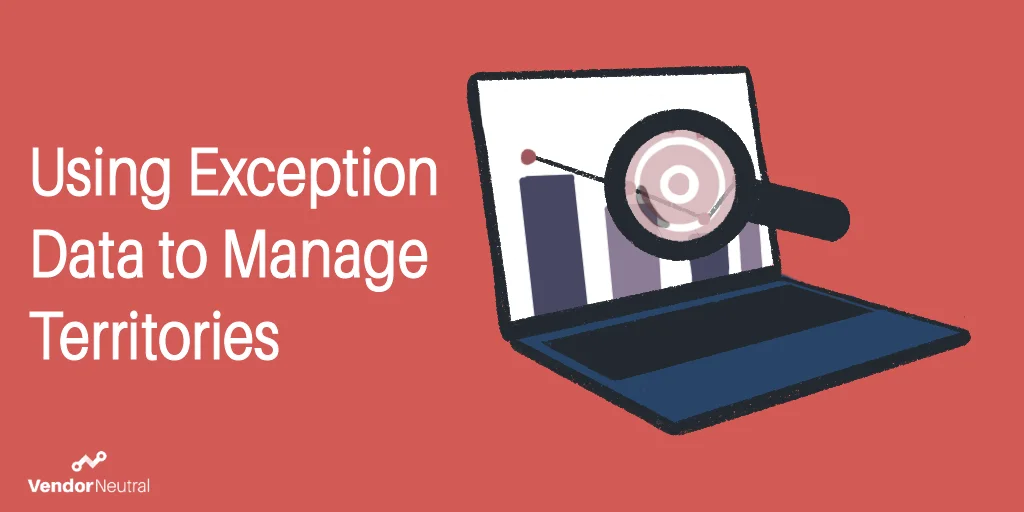Using Exception Data to Manage Territories

Using Exception Data to Manage Territories
Allocating sales resources to particular geographic areas or client segments is crucial to managing territories in sales operations. A territory must be managed effectively to maximize revenue, develop client connections, and meet overall sales goals. In today’s quickly evolving corporate climate, managing territories may be a difficult and complex operation.
Making sure the sales force properly penetrates all clients and prospects is one of the main problems of managing territories. To do this, it is necessary to carefully analyze sales data and identify any areas where performance is lacking, or there is room for development. In this blog post, we’ll discuss the importance of exception data in managing territory and show you how it can be used to spot problem regions or areas where you may grow.
Any organization that wants to efficiently allocate resources and focus sales efforts where they will have the biggest impact must manage its territories effectively. This blog article will review the importance of using exception data to manage territory and how it may improve your sales results.
What is Exception Data?
Data that deviates from typical or anticipated patterns is referred to as exception data. You can use this information to identify problem areas or opportunities where improvement is possible. Exception data can assist you in controlling territory by letting you know which customers and prospects the sales team is failing to reach out to.
Consider a scenario in which you have a sales team in charge of promoting goods or services across various markets. In that scenario, certain regions constantly outperform others. Different customer bases may differ in size or demographics, the competitive environment may differ, or the team may have access to different sales resources, among other things.
Studying exception data allows you to pinpoint problem areas and create plans to boost performance in underperforming regions. This could entail reallocating funds, giving sales representatives more coaching or training, or making additional marketing or sales support investments.

Exception data can be valuable in managing territories for several reasons:
1. Identify Opportunities for Growth
Find fresh prospects for growth that may have gone unnoticed by studying exception data. For instance, you can find out that a certain good or service is in great demand in a certain market despite the sales staff not actively pursuing it. You can take advantage of these new opportunities and promote growth in underperforming regions by reallocating resources or giving the sales team more assistance.
2. Optimize Resource Allocation
The distribution of resources, such as sales representatives, marketing assistance, and other resources, must be done with care while managing territories. You can determine which regions need more resources and which ones could already have too many by looking at exception data. By doing this, you can make the most of your investments in sales and marketing and optimize how your resources are allocated.
3. Improve Sales Performance
You can use exceptional data to pinpoint problems and create plans to enhance sales success. For instance, you might observe a specific sales representative unable to close business in a specific market. By giving the sales representative more training or coaching, you can aid in their performance improvement and assist them in generating greater outcomes in that area.
Or a certain territory frequently performs poorly because there aren’t enough sales resources there. You can improve the sales team’s ability to enter that territory by reallocating resources or providing greater support.
"You must have a comprehensive grasp of your company objectives and the key performance indicators (KPIs) that determine success to use exception data in territory management successfully."
How to Use Exception Data to Manage Territories
You must have a comprehensive grasp of your company objectives and the key performance indicators (KPIs) that determine success to use exception data in territory management successfully. The following are some typical KPIs that are pertinent to controlling territories:
- Sales revenue by territory
- Customer acquisition cost (CAC) by territory
- Sales conversion rates by territory
- Sales cycle length by territory
- Customer satisfaction by territory
Once you have identified your KPIs, you can use exception data to identify areas of concern and develop strategies to improve performance. Here are some actions to take:
1. Collect and Analyze Data
To identify areas of concern and opportunities for improvement, you need to collect and analyze data on your sales performance by territory. In order to do this, you might gather data from your sales team, examine customer data, and use tools for data analytics to spot patterns and trends.
2. Identify the Problem Areas
Following data collection and analysis, you might pinpoint problem areas that need more research. This could entail identifying regions that routinely perform poorly or breaking down sales data by customer category to find potential growth locations.
3. Create Plans to Boost Performance
You can create performance improvement initiatives once you’ve identified problem areas. This could entail shifting funds to underperforming regions, spending more on marketing or sales assistance, or giving sales representatives more coaching or training.
4. Track results and make necessary adjustments to your strategies
Monitoring performance and making necessary strategy adjustments are part of the continual process of managing territories. Setting up a system to measure your KPIs in real-time, having regular reviews of your sales team’s performance, or conducting frequent customer surveys to get feedback on your performance are some examples of how to do this.

Best Practices for Managing Territories with Exception Data
Following a few best practices may help you manage territory using exception data effectively:
- Focus on Key Metrics
You must concentrate on the crucial success indicators to manage territory using exception data successfully. Some examples are sales income, customer acquisition costs, sales conversion rates, and client happiness. You can spot problem areas and create performance improvement plans by concentrating on these important KPIs.
- Use Data Analytics Tools
Data analytics tools can be incredibly helpful when evaluating sales performance data and spotting patterns and trends. You can immediately spot problem areas by using tools like Tableau, Salesforce, and Microsoft Power BI to visualize your data.
- Get the Sales Team Involved in Data Analysis
It is crucial to incorporate your sales force in the data analysis process because they are the ones selling your goods or services directly to customers. You may better understand their difficulties and create plans to support their success by soliciting their advice and feedback on statistics on sales performance.
- Regularly Review and Adjust Your Territory Management Strategy
The process of managing territories is ongoing, so you should constantly evaluate your approach and make any necessary adjustments. The quotas for your sales staff may need to be changed, resources may need to be redistributed, or new sales support tools or technologies may need to be purchased.
Any firm must manage its territories effectively, and using exception data can help you spot problem regions and areas where you can make improvements. You may improve your sales performance and spur business growth by concentrating on key indicators, utilizing data analytics tools, involving your sales staff in data analysis, and routinely assessing and tweaking your territory management plan.
What sales technology can support this strategy?
Numerous sales tools are available to assist a territory management plan that makes use of exception data. These tools can aid sales teams in gathering, analyzing, and acting on data more successfully, enhancing their capacity to spot problem areas and improvement chances.
- Customer Relationship Management (CRM) Software
Any company trying to manage territory efficiently must have CRM software. Sales teams may manage sales pipelines, track client interactions, and execute data analysis with the help of these technologies. Additionally, CRM software offers insightful customer behavior and preferences data, enabling sales teams to see opportunities and adjust their sales methods accordingly.
- Tools for Sales Analytics
Sales teams may analyze sales data more efficiently with the aid of sales analytics solutions like Tableau, Salesforce, and Microsoft Power BI. With the aid of these tools, users can easily spot trends, patterns, and outliers by visualizing data. Sales teams can uncover opportunities and adjust their sales strategies by using sales analytics solutions, which also give useful insights into customer behavior and preferences.
- Sales Enablement Platforms
Sales teams can access content management systems, training resources, and analytics dashboards through sales enablement platforms like Seismic, Highspot, Sales Hood, and Showpad. These systems enable sales teams to access and share vital information to meet customer demands instantly and seal deals better.
- Sales Performance Management (SPM) Software
SPM tools like Xactly, CallidusCloud, and Anaplan assist businesses in better managing sales performance. These technologies allow sales managers to monitor key performance indicators, establish sales targets, and motivate their staff to succeed. SPM software also offers useful insights into sales performance trends, enabling sales managers to pinpoint problem areas and areas needing development.
- Sales Forecasting Software
Sales teams may forecast future sales performance more accurately by using tools like InsightSquared, Clari, and Aviso. These solutions examine historical sales data using machine learning algorithms to find patterns and trends that might guide sales teams’ decisions. Sales teams may more efficiently allocate resources and find opportunities by using sales forecasting software.
Ready to upgrade your sales game?
Book a meeting with us and start your digital transformation journey today. Let’s work together to select the right sales technology tools for your business needs- so you too can collect, analyze, and act on data, more effectively than anyone else in your industry!


